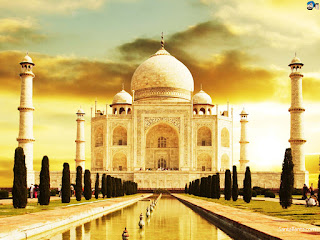Taj Mahal Architecture
The Taj Mahal covers an area of 42 acres in total with the terrain gradually sloping from south to north, towards the river Yamuna in the form of descending terraces. The main gateway situated at the end of the long watercourse, decorated in calligraphy with verses from Holy Quran and a domed central chamber, was constructed from the period 1932 to 1938. The original door of this massive sandstone gateway was made out of solid silver. It was constructed to serve the function of preventing the people from getting any glimpse of the tomb until they are right in the doorway itself. With a vertical symmetry, the main gateway of Taj Mahal stands bordered with Arabic calligraphy of verses from the Quran, made up of black stone.
The main tomb of Taj Mahal stands on a square platform that was raised 50 meter above the riverbank and was leveled with dirt to reduce seepage from the river. The four minarets on each corner of this square are detached, facing the chamfered angles of the main and are deliberately kept at 137 feet to emphasize the beautiful and spherical dome that itself is 58 feet in diameter and 81 feet high. The western side of the main tomb has the mosque and on the eastern side is the Naqqar Khana (rest/guest house), both made in red sandstone. The two structures not only provide an architectural symmetry, but also make for an aesthetic color contrast. One can only marvel at the mosque and the rest house as despite being on the opposite ends, the two are mirror image of each other.
Out of the total area of 580 meter by 300 meter, the garden alone covers 300 meter by 300 meter. The immaculate symmetry with which this garden has been laid out can be experienced everywhere. The Islamic style architecture of this garden also has a well defined meaning that symbolizes spirituality and according to the Holy Quran, the lush green, well watered is a symbol of Paradise in Islam. The raised pathways divide each of the four quarters into 16 flowerbeds with around 400 plants in each bed. Even today, the garden boasts of being a tranquil and soothing region in the entire complex and is considered best place for taking snaps of the main tomb.
A shadowy burial crypt inside the Taj Mahal houses the tombs of Mumtaz Mahal and Shah Jahan himself, who was buried there after he died. Above these tombs is the main chamber that has the false tombs and perforated marble screens have been used to transmit light into the burial chamber, typical of mausoleums of the Mughals. Semi-precious stones are exquisitely inlaid in both the tombs. Calligraphic inscriptions of the ninety nine names of Allah can also be found on the sides of actual tomb of Mumtaz Mahal. The Taj has some wonderful specimens of polychrome inlay art both in the interior and exterior on the dados, on cenotaphs and on the marble jhajjhari (jali-screen) around them. Shah Jahan's tomb, which lies next to that of Mumtaz Mahal, was never planned and deranges the otherwise perfect symmetry of the Taj.
Taj Mahal Facts
Fast Facts
Year of Construction: 1631
Completed In: 1653
Time Taken: 22 years
Built By: Shah Jahan
Dedicated to: Mumtaz Mahal (Arjumand Bano Begum), the wife of Shah Jahan
Location: Agra (Uttar Pradesh), India
Building Type: Islamic tomb
Architecture: Mughal (Combination of Persian, Islamic and Indian architecture style)
Architect: Ustad Ahmad Lahauri
Cost of Construction: 32 crore rupees
Number of workers: 20,000
Highlights: One of the Seven Wonders of the World; A UNESCO World Heritage Site
Timings: Sunrise to Sunset (Friday closed)
Fee: Rs 750 (Foreign Tourists)
Rs 510 (Citizens of SAARC & BIMSTEC Countries)
Rs 20 (Domestic Indian Tourists)
No Entry Fee for children below 15 years of age (Domestic or Foreigner)
Interesting Facts Of Taj Mahal
- Before his accession to the throne, Shah Jahan was popularly known as Prince Khurram.
- Shah Jahan fell in love with the beautiful Arjumand Bano Begum and married her, making her his third wife.
- Arjumand Bano Begum was christened by Shah Jahan as Mumtaz Mahal, meaning the “Chosen One Of The Palace” or “Jewel of the Palace”.
- Shah Jahan lost Mumtaz Mahal, when she died giving birth to their 14h child.
- For the transportation of the construction materials, more than 1,000 elephants were employed.
- As many as 28 different varieties of semi-precious and precious stones were used to adorn the Taj with exquisite inlay work.
- Depending on what time of the day it is and whether or not there’s moon at night, Taj Mahal appears to be of different color every time. Some even believe that this changing pattern of colors depict different moods of a woman.
- Passages from Quran have been used as decorative elements throughout the complex.
- On the sides of the actual tomb of Mumtaz Mahal, 99 names of Allah can be found as calligraphic inscriptions.
- Taj Mahal was built in stages, with the plinth and the tomb taking up roughly 15 years. Building of minarets, mosque, jawab, and gateway took additional 5 years to be completed.
- Different types of marbles used in construction of Taj Mahal were brought over from many different regions & countries: Rajasthan, Punjab, China, Tibet, Afghanistan, Srilanka, & Arabia.
- Many precious stones and Lapis Lazuli (a semi-precious stone) were ripped off from its walls by the Britishers during the Indian rebellion of 1857.
- Taj Mahal attracts 2-4 million visitors annually with over 200,000 from overseas.





No comments:
Post a Comment